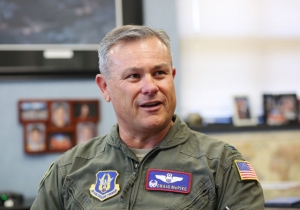Leading the 916th Air Refueling Wing
By Joey Pitchford
Published in News on June 28, 2018 5:50 AM

News-Argus/CASEY MOZINGO
Col. Craig McPike sits down in his office to talk about his Air Force career and goals as the commander of the 916th Air Refueling Wing.

News-Argus/CASEY MOZINGO
A model refueling tanker sits on display in front of a board of patches, chains and books from Col. Craig McPike's Air Force career.
Col. Craig McPike, the new commander of the 916th Air Refueling Wing, has quite a bit of work ahead of him. With the brand-new KC-46A Pegasus aerial refueling fleet coming in 2019 to Seymour Johnson Air Force Base, millions of dollars in construction to coordinate and an expected surge in hiring for the wing -- never mind the regular challenges of keeping a military wing running -- there is plenty for McPike to work on now that he is settled in at Seymour Johnson.
That sits just fine with McPike, who, as an active duty airman in the early 1990s, always wanted to do more.
Born in Houston, Texas, McPike graduated from Texas A&M in 1993 before joining the Air Force the following year. During his time on active duty, McPike set high goals for himself. He wanted to be a wing commander, a test pilot, but eventually felt as though he had reached a plateau. So, he initially turned to the private sector, looking for work as a commercial pilot.
"Fortunately for me, I did not get picked up as a commercial airline pilot. During that time, the airlines were struggling. It was after 2001, and the airlines were laying off heavily.
"Nowadays, they're hiring like gangbusters, and in my opinion, it would be fairly easy to find an airline to go work for."
Instead in 2003, McPike turned to the Air Force reserve, where he became an Active Guard Reserve -- a full time reservist -- essentially placing him back on active duty within the testing community. McPike went on to test all kinds of Air Force technology from airplanes to radar systems during the 11 years he spent in the test community.
That career led into a staff position at Robins Air Force Base in Georgia, and then to a position with the Air Force Reserve Command. He came to Seymour Johnson in July 2017 as the 916th's vice commander, and is now taking command just shy of a year later.
McPike said that his time working for the AFRC was particularly valuable when it comes to running the 916th.
While working there, he became part of the AFRC planning and programming staff -- putting together the AFRC's budget to be approved by Congress. The budget is done on a continuing resolution, meaning that a yearly budget is split up into small slices, each of which must be fully spent during its given time frame before the next will be allocated.
"The budget, or lack thereof, really impacts us the most in the reserve," he said. "So learning about that and how that's built, it really helps me here because I know what's really going to happen and how it's going to play out, and I'm able to message that to our airmen.
"And then, to come up with COAs -- courses of action -- that will help us get the maximum effectiveness out of the little bit of money that we have over the short amount of time that the CR goes."
McPike's time as vice commander and his work at the Pentagon have helped him prepare not only for the financial side of leadership but also for another central responsibility -- making sure airmen have the resources they need to carry out their mission.
With the KC-46 on its way, McPike wants to do everything in his power to help keep his airmen in good shape. The wing has undergone a series of major deployments from October through January, with another coming in July and again next March. To make that happen, reservists must come in off their regular civilian jobs for a lengthy training regiment to get them current qualified on chemical warfare procedures, small arms usage and other skills.
"So, as we convert, that means they've gotta go somewhere else, probably Althas, Oklahoma or McConnell [Air Force Base] for four months to convert, and that's essentially a deployment," he said.
"One of the challenges I'm trying to work on is to somehow be able to do some of that training here. We're going to have a simulator, we're going to have flight safety instructors, so what I'd like to do is be able to do some of that initial cadre training in-house."
